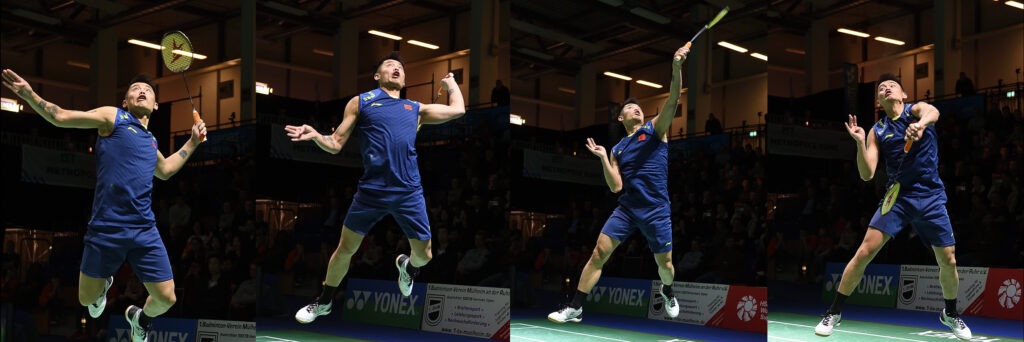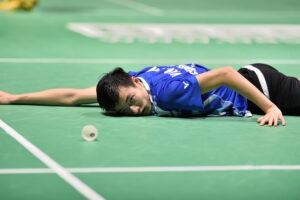Is there a better feeling than the sound of a thundering powersmash that you’ve just hammered down the line? I don’t think so and it is also no suprise that so many people are asking, how they can improve the power and speed in their attacking shots.
In my eyes, there are four factors, that have an impact on the power of your smash and if I should rank their importance it would look like this:
-
- Technique and timing
- Mobility and movement patterns
- Power
- Equipment
Now let’s have a closer look at all four aspects:
Technique and Timing
Even though a lot of people think, you need a lot of power to hit hard there is no question for me, that timing and technique have a much bigger impact on the speed of your smash. Just have a look at some small asian players like Kevin Sanjaya Sukamuljo. He doesn’t look like he has a lot of power in his upper body and I am sure a lot of hobby players can lift more weights in the gym than him. But if you see guys like him hitting a smash you will realize, what a good technique and the perfect timing can do.
“Timing and technique have a much bigger impact on the speed of your smash than raw power”
But what means “a good technique and a good timing”? To be honest, there is no easy answer to that question and there are so many aspects that are important when you want to develop a perfect overhead movement in badminton but in my eyes there are a few small things, that can already have a huge impact if done correctly.
Grip, wrist and forearm
First of all let’s have a look at the arm, especially the grip and the wrist and here many players are already making a big mistake. A common thing you see are players holding the racket like a pan (the so called panhandle grip), standing parallel to the net and hitting with a lot of wrist movement. That technique will help you to hit the shuttle easily, because you always have the racket in front of you but it will take every chance away of creating power in your shots.
The biggest source for power shots is the rotation in your forearm. A small movement here can create a lot of speed and momentum in your racket but in only works if you:
- are having the right grip, the so called V-Grip (turn the panhandlegrip about 90°)
- have angle between your forearm and your racket
- have a fixed wrist, otherwise the power from the rotation won’t transform properly into your racket
I already made a short video about all three points so it will get a lot clearer what I mean with it:
Hip, shoulder and elbow
The three things mentioned before have a huge impact on your power, but if you really want to hit superhard, you also have to use the rest of your body, and here especially timing comes into play. Again take a look at players like Sukamuljo and in slow motion it is clear to see, that he not only creates power from is arm, but from his full body.
Top players start creating energy by pushing the dominant hip forwards. That will create a tension in your upper body that helps to accelerate the shoulder and the same thing happens in the arm again. The elbow accelereates and gets in front of the hand and racket and finally a stretching of the arm and the rotation in the upperarm and forearm follows. In the following series of pictures from 2-times olympic champion Lin Dan you can see those different phases.

As this is a very complex movement, that is hard to describe in words the follwing video gives you a brief walk through all the phases and shows you some classic mistakes and exercises for your training.
Mobility and movement patterns
This may be a little suprise for you, but I think that mobility and movement patterns are even more important than power, because they are the foundation for a good technique. In the video above I talk about keeping the elbow behind your body as long as possible to give yourself a long way to accelerate the racket. But that is only possible if you have a certain level of mobility, especially in the upper part of your spine. Furthermore you also need a good shouldermobility, if you want to hit the shuttle up high with a smooth and round movement.
If you think that this could maybe be your problem, and if you feel stiff in your upper body, i recommend you to have a look at my article about mobility and stability. There you get an idea of the importance of mobility for your technique and I also show you different kinds of exercises to improve in that area. (Here you find the arcticle)
“If you try to teach someone a clear or a smash, when he is not able to throw a ball with a fluent movment, you will fail!”
Besides mobility I already mentioned movement patterns, which could be characterized as the coordination and composition of movements, where different muscles and joints are involved. An example for an important movement pattern to hit a smash would be throwing. If you compare the smash movement to the throw of a ball you will find a lot of similarities and especially the timing and coordination of all the single movements can be practiced extremly good by just practicing to throw You could say, that throwing is the nescessary foundation for a overhead shot, or in other words, if you try to teach someone a clear or a smash, when he is not able to throw a ball with a fluent movment, you will fail. So try to get these basics right, and the technique for a smash will come a lot easier and natural to you or to your players.
Powertraining
Now we come to the point most of you probably have been waiting for: power. Even though a good technique is the most important thing for a hard smash, power will help to hit even harder so powertraining defintly can make a difference but I would only recommend it to experienced players, that have a solid technique and good movement patterns. Otherwise an increase in power can lead to a lot of problems and injuries, so defintly start out slowly if you want to try some of the following things.

When we went throught the technique of a smash you have probably realized, that a lot of different muscles are playing a part in the movement. The biggest mistake that you can make to improve power for a smash, is using machines in the gym because there you only work on very few muscles in an isolated and unfucntional way. Unfunctional means, that the movement you perform has nothing to do with the actual movement you are aiming for. Let’s take the butterfly machine as an example. There you train your pectoralis (chest), definitly an important muscle when you hit a smash, but if you compare the movements you will realize that there are not many similarities, so don’t expect that something like this will give you a huge benefit for your smash.
When you want to train the right muscles you should also go for exercises and movements, that are not so far away from smashing. The following three things are classic examples that you could put into your training routines:
Heavy rackets
Hitting smashes with a heavy racket, it doesn’t get any closer than that. The heavy racket can be a really useful tool, if you want to strenghten your muscles in a very badminton specific way, but be careful in the beginning and start out slow, with a racket that is not too heavy (< 130 gramms). A classic method is switching between the heavy racket and your normal one, for exampl 3×15 smashes heavy racket, 3×15 smashes normal racket.
The racket can also be a helpful tool to improve the power in your forearm and your fingers, for example by using it for stick smashes or just killing at the net by squeezing the grip.
I also talk about it in my video about trainingtools for badmintonplayers (Link)
Forearm- and Handpower trainer
Besides the heavy racket there are also specific tools for the forearm and the power in your wrist. I especially like the forearmtrainer and tools for grip power like the ones you can see in the pictures below.
When you use tools like that, there are two important things. First of all you should not do it to often in the beginning, as these exercises are more of an isolated training so they can cause serious problems, especially in the elbow. Secondly try to execute these exercises with speed and not too long/not too many repetitions. Maximum power and speed are more important than strength endurance.
Medcine Ball Throws
Last but not least medicine ball throws are a good way to improve explosive strenght and are used by almost any professional sport where throwing is involved. There are different ways and directions how you can perform these throws and I would recommend to go for a mix to prevent an overuse in the beginning and to strenghten all the important muscles for your smash.
To get an idea of different exercises have a look at this quick video with three examples:
Once again, please keep in mind, that power training is very demanding, and you need a certain amount of strength and stability to do it and always perform a proper warm up, before you start out!
Equipment
Last but not least, I want to talk about equipment and even though the racket or the stinging won’t turn a bad smash into a good one, the material has an impact on the performance and on the power in your shots. The badminton industrie is always developing new technologies and by now there is so much science behind rackets and stringing, that you can write plenty of articles about it. To keep it simple I will focus only on two aspects: the racket and the stringing.
Racket
There are two general charecteristics in rackets, that have an influence on the power in your shots. First of all it is the weight and the balance and you should choose a head heavy racket, if you want to hit hard. Especially in shots where you can use a bigger swing (like a smash for example) the head heavy racket will help you to accelerate. Secondly i would recommend to go for a stiff racket. That will also allow you to transfer more speed and power from your racket into the shuttle. Here are some examples for rackets, that fit that characterization:
Even though, those two things can help, there is one very important thing to mention: you need a certain amount of power if you want to make use of head heavy and stiff rackets. I would never recommend those kind of rackets to younger players, because they don’t have the power to accelerate the heavy racket head, and with a slow swing a stiff racket will also be counter productive in terms of power. So if you don’t have a lot of power, do not choose the super heavy and super stiff models.
Stringing
Last but not least let’s have a look at the stringing of the racket as this is the part of your racket where you have contact with the shuttle. On one hand the tension is important. Normal rackets come with around 9-11kg (~20-24lbs), a little bit more tension can help you to get a shorter contact with the shuttle and therefore help you to hit harder. One thing to keep in mind here ist, that the sweet spot (the spot on your strings where you can hit clean without to much vibration) gets smaller with higher tension. Best thing i can recommend here is to try a little bit around with different tensions and see what works best for you. If you are not very experienced I would recommend you to stay below 13kg (~28lbs).
Last aspect ist the thickness of the strings. Thinner strings usually allow you to hit a little bit harder but they break a lot faster, especially if you are hitting close to the frame. Here are four examples of thinner strings that I already tried out and that I can recommend. Until last year I played the normal BG80 (on the left) but now i switched to the Aerobite (on the right), which is a combination of two different strings, a very thin one and a little bit thicker one with a lot of grip and so far I am absolutly amazed by the combination of power and control that comes with that string.
Same thing here, try around with some different strings and find out what fits best for you and your game.
Conclusion and recommentadions
I hope you realized, that there is so much more to hitting hard smashes than just raw power and I hope you found a few new ideas how you can work on your game to become more dangerous from the rearcourt. I think the biggest potential for almost any player lies in technique and the quality of basic movements. Even international top players work on these basics in their daily training, for example by just hitting 100 smashes with focus on all the small details, that can make a massive difference in the end.
To end this article I want to give you some practical recommendations, how you can specificly work on the power in your shots:
Beginners and casual players:
Start every trainingsession with a short mobility work out with focus on you upper body. Here you find different exercises you can implement in your warm up. In the session try to work on a fluent and effortless movement whenever you have the chance. It works best if someone is feeding you, and you have no pressure when you hit the shuttle. A tip here: don’t overthink it in the beginning, and just focus on the following three things:
- hit the shuttle downwards with a good angle (you can only do that, when you hit up high)
- before you hit the shuttle be relaxed as long as possible
- listen to the sound of the impact (a clear and loud sound is one of the best indicators for a good smash)
Another great tool for your training are videos. Watch a few slow motion clips from top players (you find plenty on youtube) and also ask a friend if he can record your movement. Analyze and compare the points i mentioned in the first part of the article and try to figure out, where you have room for development.
Intermediate and experienced players
As is said, even top players still work on the basic techniques so you should also implement the same things in the training like beginners and casual players. Besides that you can shift it a little bit up by mixing in a heavy racket.
Besides the court you can implement 2-3 weekly sessions where you work on the power in your arm and shoulders with the exercises and tools i presented above. If you have the possibilty, connect your power training with training in the hall, so your muscles can adapt even better to the badminton specific movements.
One very important thing in the end: If you only focus on exercises that will improve you smash, training will become very onesided, most likely you will develop a dysbalance between your muscles in the front and in the back and that will almost certainly cause shoulder injuries. It is important to balance out your powertraining, so the more you work on your smash, the more you also have to invest into your back muscles, and you rotator cuff (the muscles around your shoulder) to avoid a bad posture.
Tobias Wadenka




